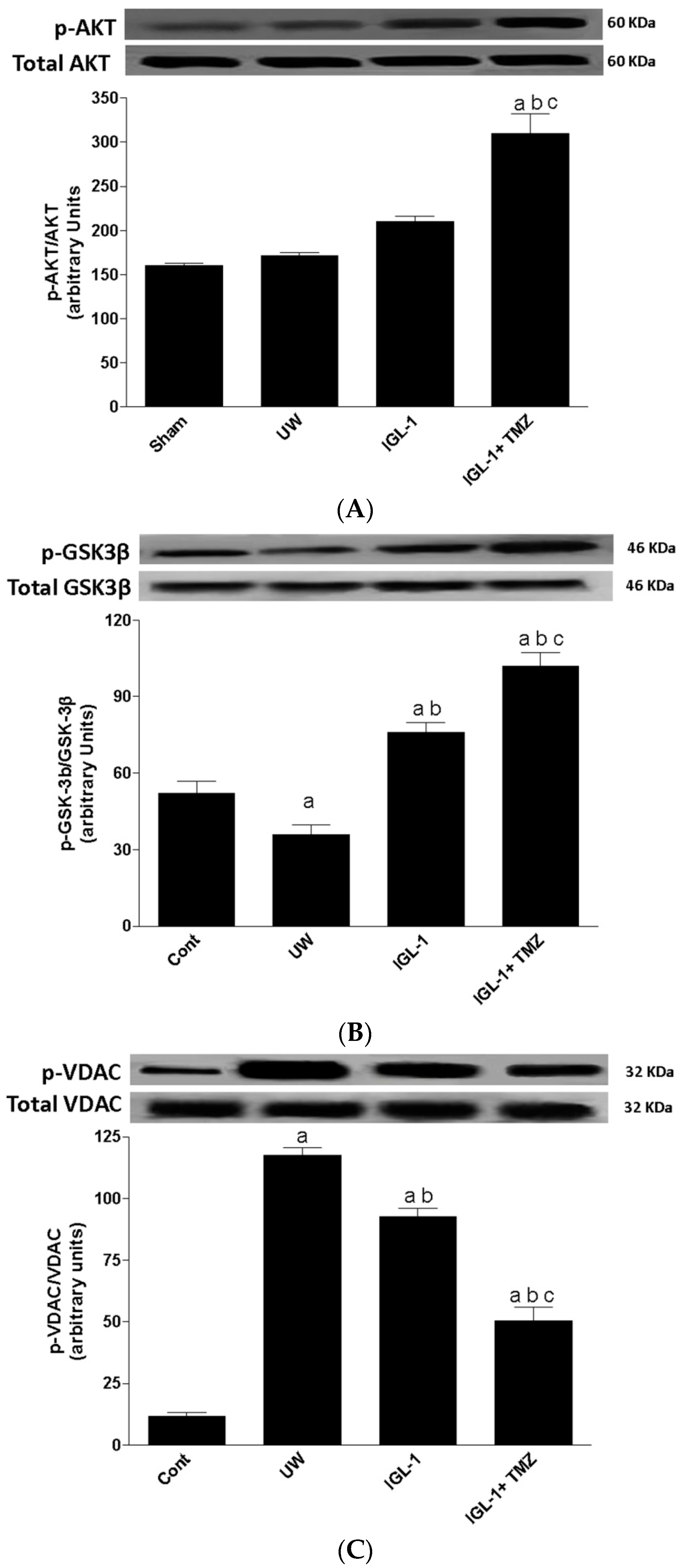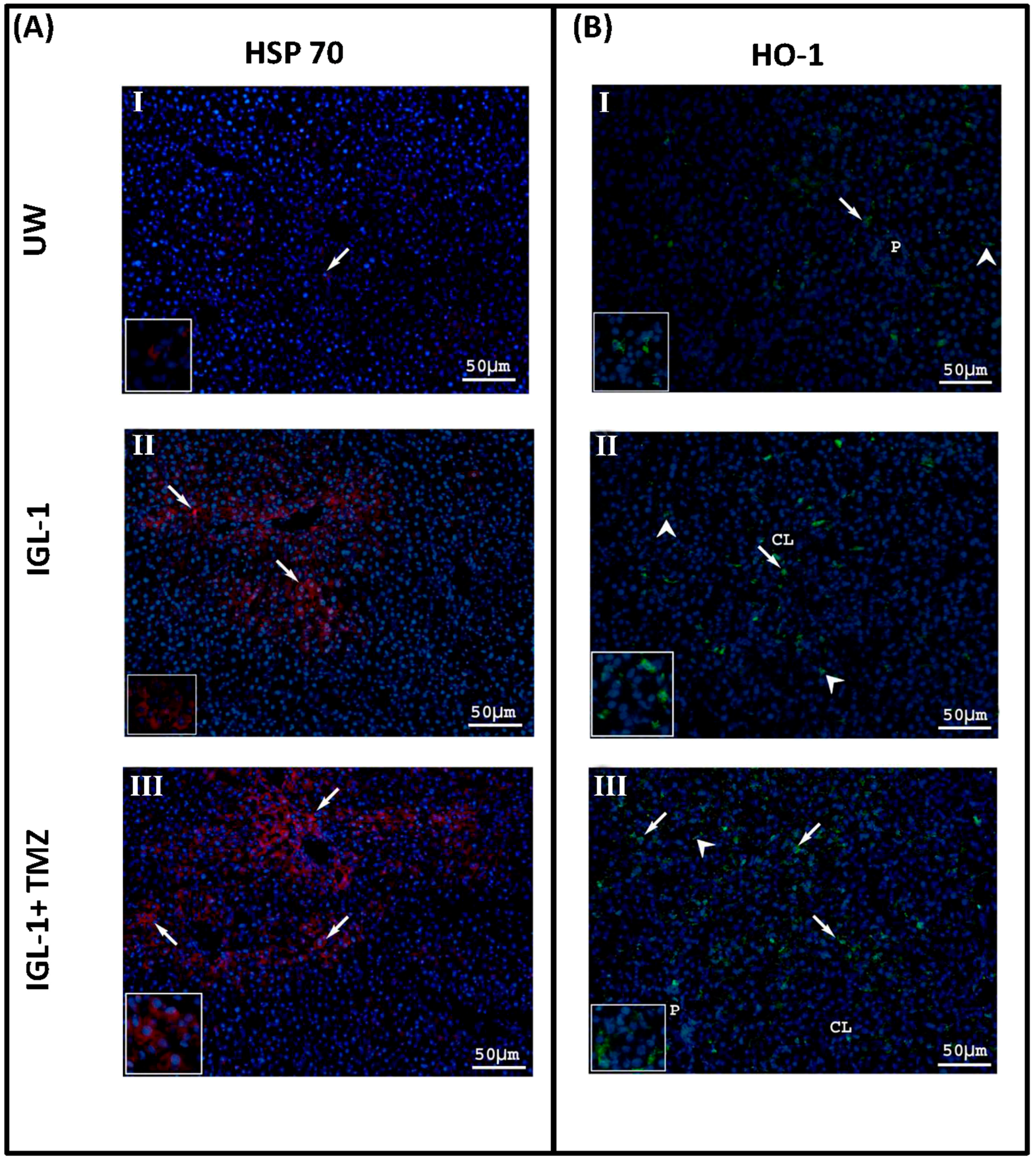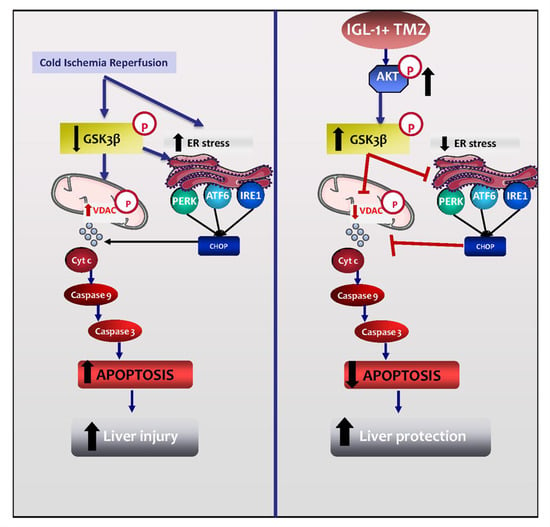GSK3β and VDAC Involvement in ER Stress and Apoptosis Modulation during Orthotopic Liver Transplantation
Abstract
:1. Introduction
2. Results
3. Discussion
4. Materials and Methods
4.1. Experimental Animals
4.2. Experimental Design
4.3. Biochemical Determinations
4.3.1. Transaminase Assay
4.3.2. Glutamate Dehydrogenase Activity
4.3.3. Lipid Peroxidation
4.3.4. TUNEL Assay
4.3.5. Histology
4.3.6. Western Blotting Analysis
4.3.7. Heme-Oxygenase (HO-1) Immunohistochemistry
4.3.8. Heat Shock Protein (HSP-70) Immunohistochemistry
4.4. Statistics
Acknowledgments
Author Contributions
Conflicts of Interest
References
- Zhai, Y.; Petrowsky, H.; Hong, J.C.; Busuttil, R.W.; Kupiec-Weglinski, J.W. Ischaemia-reperfusion injury in liver transplantation—From bench to bedside. Nat. Rev. Gastroenterol. Hepatol. 2013, 10, 79–89. [Google Scholar] [CrossRef] [PubMed]
- Adam, R.; Delvart, V.; Karam, V.; Ducerf, C.; Navarro, F.; Letoublon, C.; Belghiti, J.; Pezet, D.; Castaing, D.; le Treut, Y.P.; et al. Compared efficacy of preservation solutions in liver transplantation: A long-term graft outcome study from the European Liver Transplant Registry. Am. J. Transplant. 2015, 15, 395–406. [Google Scholar] [CrossRef] [PubMed]
- Bejaoui, M.; Pantazi, E.; Folch-Puy, E.; Baptista, P.M.; Garcia-Gil, A.; Adam, R.; Rosello-Catafau, J. Emerging concepts in liver graft preservation. World J. Gastroenterol. 2015, 21, 396–407. [Google Scholar] [CrossRef] [PubMed]
- Mosbah, I.B.; Zaouali, M.A.; Martel, C.; Bjaoui, M.; Abdennebi, H.B.; Hotter, G.; Brenner, C.; Rosello-Catafau, J. IGL-1 solution reduces endoplasmic reticulum stress and apoptosis in rat liver transplantation. Cell Death Dis. 2012, 3, e279. [Google Scholar] [CrossRef] [PubMed] [Green Version]
- Ben Mosbah, I.; Casillas-Ramirez, A.; Xaus, C.; Serafin, A.; Rosello-Catafau, J.; Peralta, C. Trimetazidine: Is it a promising drug for use in steatotic grafts? World J. Gastroenterol. 2006, 12, 908–914. [Google Scholar] [CrossRef] [PubMed]
- Ben Mosbah, I.; Massip-Salcedo, M.; Fernandez-Monteiro, I.; Xaus, C.; Bartrons, R.; Boillot, O.; Rosello-Catafau, J.; Peralta, C. Addition of adenosine monophosphate-activated protein kinase activators to University of Wisconsin solution: A way of protecting rat steatotic livers. Liver Transplant. 2007, 13, 410–425. [Google Scholar] [CrossRef] [PubMed]
- Zaouali, M.A.; Ben Mosbah, I.; Boncompagni, E.; Ben Abdennebi, H.; Mitjavila, M.T.; Bartrons, R.; Freitas, I.; Rimola, A.; Rosello-Catafau, J. Hypoxia inducible factor-1α accumulation in steatotic liver preservation: Role of nitric oxide. World J. Gastroenterol. 2010, 16, 3499–3509. [Google Scholar] [CrossRef] [PubMed] [Green Version]
- Zaouali, M.A.; Boncompagni, E.; Reiter, R.J.; Bejaoui, M.; Freitas, I.; Pantazi, E.; Folch-Puy, E.; Abdennebi, H.B.; Garcia-Gil, F.A.; Rosello-Catafau, J. AMPK involvement in endoplasmic reticulum stress and autophagy modulation after fatty liver graft preservation: A role for melatonin and trimetazidine cocktail. J. Pineal Res. 2013, 55, 65–78. [Google Scholar] [CrossRef] [PubMed]
- Busuttil, R.W.; Tanaka, K. The utility of marginal donors in liver transplantation. Liver Transplant. 2003, 9, 651–663. [Google Scholar] [CrossRef] [PubMed]
- Pantazi, E.; Zaouali, M.A.; Bejaoui, M.; Folch-Puy, E.; Ben Abdennebi, H.; Varela, A.T.; Rolo, A.P.; Palmeira, C.M.; Rosello-Catafau, J. Sirtuin 1 in rat orthotopic liver transplantation: An IGL-1 preservation solution approach. World J. Gastroenterol. 2015, 21, 1765–1774. [Google Scholar] [CrossRef] [PubMed]
- Dugo, L.; Collin, M.; Thiemermann, C. Glycogen synthase kinase 3β as a target for the therapy of shock and inflammation. Shock 2007, 27, 113–123. [Google Scholar] [CrossRef] [PubMed]
- Zhai, P.; Sadoshima, J. Overcoming an energy crisis: An adaptive role of glycogen synthase kinase-3 inhibition in ischemia/reperfusion. Circ. Res. 2008, 103, 910–913. [Google Scholar] [CrossRef] [PubMed]
- Colombini, M. VDAC structure, selectivity, and dynamics. Biochim. Biophys. Acta 2012, 1818, 1457–1465. [Google Scholar] [CrossRef] [PubMed]
- Goncalves, R.P.; Buzhysnskyy, N.; Scheuring, S. Mini review on the structure and supramolecular assembly of VDAC. J. Bioenerg. Biomembr. 2008, 40, 133–138. [Google Scholar] [CrossRef] [PubMed]
- Pastorino, J.G.; Hoek, J.B.; Shulga, N. Activation of glycogen synthase kinase 3β disrupts the binding of hexokinase II to mitochondria by phosphorylating voltage-dependent anion channel and potentiates chemotherapy-induced cytotoxicity. Cancer Res. 2005, 65, 10545–10554. [Google Scholar] [CrossRef] [PubMed]
- Shoshan-Barmatz, V.; Golan, M. Mitochondrial VDAC1: Function in cell life and death and a target for cancer therapy. Curr. Med. Chem. 2012, 19, 714–735. [Google Scholar] [CrossRef] [PubMed]
- Jellestad, L.; Fink, T.; Pradarutti, S.; Kubulus, D.; Wolf, B.; Bauer, I.; Thiemermann, C.; Rensing, H. Inhibition of glycogen synthase kinase (GSK)3β improves liver microcirculation and hepatocellular function after hemorrhagic shock. Eur. J. Pharmacol. 2014, 724, 175–184. [Google Scholar] [CrossRef] [PubMed]
- Yan, Y.; Li, G.; Tian, X.; Ye, Y.; Gao, Z.; Yao, J.; Zhang, F.; Wang, S. Ischemic preconditioning increases GSK3β/β-catenin levels and ameliorates liver ischemia/reperfusion injury in rats. Int. J. Mol. Med. 2015, 35, 1625–1632. [Google Scholar] [PubMed]
- Rolo, A.P.; Teodoro, J.S.; Peralta, C.; Rosello-Catafau, J.; Palmeira, C.M. Prevention of I/R injury in fatty livers by ischemic preconditioning is associated with increased mitochondrial tolerance: The key role of ATPsynthase and mitochondrial permeability transition. Transpl. Int. 2009, 22, 1081–1090. [Google Scholar] [CrossRef] [PubMed]
- Huang, S.; Zhu, M.; Wu, W.; Rashid, A.; Liang, Y.; Hou, L.; Ning, Q.; Luo, X. Valproate pretreatment protects pancreatic β-cells from palmitate-induced ER stress and apoptosis by inhibiting glycogen synthase kinase-3β. J. Biomed. Sci. 2014, 21, 38. [Google Scholar] [CrossRef] [PubMed]
- Nishihara, M.; Miura, T.; Miki, T.; Tanno, M.; Yano, T.; Naitoh, K.; Ohori, K.; Hotta, H.; Terashima, Y.; Shimamoto, K. Modulation of the mitochondrial permeability transition pore complex in GSK3β-mediated myocardial protection. J. Mol. Cell. Cardiol. 2007, 43, 564–570. [Google Scholar] [CrossRef] [PubMed]
- Peralta, C.; Brenner, C. Endoplasmic reticulum stress inhibition enhances liver tolerance to ischemia/reperfusion. Curr. Med. Chem. 2011, 18, 2016–2024. [Google Scholar] [CrossRef] [PubMed]
- Ilmakunnas, M.; Tukiainen, E.M.; Rouhiainen, A.; Rauvala, H.; Arola, J.; Nordin, A.; Makisalo, H.; Hockerstedt, K.; Isoniemi, H. High mobility group box 1 protein as a marker of hepatocellular injury in human liver transplantation. Liver Transplant. 2008, 14, 1517–1525. [Google Scholar] [CrossRef] [PubMed]
- Hadj Ayed Tka, K.; Mahfoudh Boussaid, A.; Zaouali, M.A.; Kammoun, R.; Bejaoui, M.; Ghoul Mazgar, S.; Rosello Catafau, J.; Ben Abdennebi, H. Melatonin modulates endoplasmic reticulum stress and Akt/GSK3β signaling pathway in a rat model of renal warm ischemia reperfusion. Anal. Cell. Pathol. 2015, 2015, 635172. [Google Scholar] [CrossRef] [PubMed]
- Zaouali, M.A.; Mosbah, I.B.; Abdennebi, H.B.; Calvo, M.; Boncompagni, E.; Boillot, O.; Peralta, C.; Rosello-Catafau, J. New insights into fatty liver preservation using Institute Georges Lopez preservation solution. Transplant. Proc. 2010, 42, 159–161. [Google Scholar] [CrossRef] [PubMed] [Green Version]
- Nishihara, M.; Miura, T.; Miki, T.; Sakamoto, J.; Tanno, M.; Kobayashi, H.; Ikeda, Y.; Ohori, K.; Takahashi, A.; Shimamoto, K. Erythropoietin affords additional cardioprotection to preconditioned hearts by enhanced phosphorylation of glycogen synthase kinase 3β. Am. J. Physiol. Heart Circ. Physiol. 2006, 291, H748–H755. [Google Scholar] [CrossRef] [PubMed]
- Ma, N.; Bai, J.; Zhang, W.; Luo, H.; Zhang, X.; Liu, D.; Qiao, C. Trimetazidine protects against cardiac ischemia/reperfusion injury via effects on cardiac miRNA21 expression, Akt and the Bcl2/Bax pathway. Mol. Med. Rep. 2016, 14, 4216–4222. [Google Scholar] [PubMed]
- Gong, X.; Fan, G.; Wang, W.; Wang, G. Trimetazidine protects umbilical cord mesenchymal stem cells against hypoxia and serum deprivation induced apoptosis by activation of Akt. Cell. Physiol. Biochem. 2014, 34, 2245–2255. [Google Scholar] [CrossRef] [PubMed]
- Wu, Q.; Qi, B.; Liu, Y.; Cheng, B.; Liu, L.; Li, Y.; Wang, Q. Mechanisms underlying protective effects of trimetazidine on endothelial progenitor cells biological functions against H2O2-induced injury: Involvement of antioxidation and Akt/eNOS signaling pathways. Eur. J. Pharmacol. 2013, 707, 87–94. [Google Scholar] [CrossRef] [PubMed]
- Das, S.; Wong, R.; Rajapakse, N.; Murphy, E.; Steenbergen, C. Glycogen synthase kinase 3 inhibition slows mitochondrial adenine nucleotide transport and regulates voltage-dependent anion channel phosphorylation. Circ. Res. 2008, 103, 983–991. [Google Scholar] [CrossRef] [PubMed]
- Domanski, L.; Sulikowski, T.; Safranow, K.; Pawlik, A.; Olszewska, M.; Chlubek, D.; Urasinska, E.; Ciechanowski, K. Effect of trimetazidine on the nucleotide profile in rat kidney with ischemia-reperfusion injury. Eur. J. Pharm. Sci. 2006, 27, 320–327. [Google Scholar] [CrossRef] [PubMed]
- Morin, D.; Elimadi, A.; Sapena, R.; Crevat, A.; Carrupt, P.A.; Testa, B.; Tillement, J.P. Evidence for the existence of [3H]-trimetazidine binding sites involved in the regulation of the mitochondrial permeability transition pore. Br. J. Pharmacol. 1998, 123, 1385–1394. [Google Scholar] [CrossRef] [PubMed]
- Mahfoudh-Boussaid, A.; Zaouali, M.A.; Hauet, T.; Hadj-Ayed, K.; Miled, A.H.; Ghoul-Mazgar, S.; Saidane-Mosbahi, D.; Rosello-Catafau, J.; Ben Abdennebi, H. Attenuation of endoplasmic reticulum stress and mitochondrial injury in kidney with ischemic postconditioning application and trimetazidine treatment. J. Biomed. Sci. 2012, 19, 71. [Google Scholar] [CrossRef] [PubMed] [Green Version]
- Ben Mosbah, I.; Alfany-Fernandez, I.; Martel, C.; Zaouali, M.A.; Bintanel-Morcillo, M.; Rimola, A.; Rodes, J.; Brenner, C.; Rosello-Catafau, J.; Peralta, C. Endoplasmic reticulum stress inhibition protects steatotic and non-steatotic livers in partial hepatectomy under ischemia-reperfusion. Cell Death Dis. 2010, 1, e52. [Google Scholar] [CrossRef] [PubMed] [Green Version]
- Han, G.; Casson, R.J.; Chidlow, G.; Wood, J.P. The mitochondrial complex I inhibitor rotenone induces endoplasmic reticulum stress and activation of GSK3β in cultured rat retinal cells. Investig. Ophthalmol. Vis. Sci. 2014, 55, 5616–5628. [Google Scholar] [CrossRef] [PubMed]
- Dong, M.; Hu, N.; Hua, Y.; Xu, X.; Kandadi, M.R.; Guo, R.; Jiang, S.; Nair, S.; Hu, D.; Ren, J. Chronic Akt activation attenuated lipopolysaccharide-induced cardiac dysfunction via Akt/GSK3β-dependent inhibition of apoptosis and ER stress. Biochim. Biophys. Acta 2013, 1832, 848–863. [Google Scholar] [CrossRef] [PubMed]
- Evankovich, J.; Cho, S.W.; Zhang, R.; Cardinal, J.; Dhupar, R.; Zhang, L.; Klune, J.R.; Zlotnicki, J.; Billiar, T.; Tsung, A. High mobility group box 1 release from hepatocytes during ischemia and reperfusion injury is mediated by decreased histone deacetylase activity. J. Biol. Chem. 2010, 285, 39888–39897. [Google Scholar] [CrossRef] [PubMed]
- Cardinal, J.; Pan, P.; Dhupar, R.; Ross, M.; Nakao, A.; Lotze, M.; Billiar, T.; Geller, D.; Tsung, A. Cisplatin prevents high mobility group box 1 release and is protective in a murine model of hepatic ischemia/reperfusion injury. Hepatology 2009, 50, 565–574. [Google Scholar] [CrossRef] [PubMed]
- Franco-Gou, R.; Mosbah, I.B.; Serafin, A.; Abdennebi, H.B.; Rosello-Catafau, J.; Peralta, C. New preservation strategies for preventing liver grafts against cold ischemia reperfusion injury. J. Gastroenterol. Hepatol. 2007, 22, 1120–1126. [Google Scholar] [CrossRef] [PubMed]
- Kamada, N.; Calne, R.Y. Orthotopic liver transplantation in the rat. Technique using cuff for portal vein anastomosis and biliary drainage. Transplantation 1979, 28, 47–50. [Google Scholar] [CrossRef] [PubMed]
- Zaouali, M.A.; Bardag-Gorce, F.; Carbonell, T.; Oliva, J.; Pantazi, E.; Bejaoui, M.; Ben Abdennebi, H.; Rimola, A.; Rosello-Catafau, J. Proteasome inhibitors protect the steatotic and non-steatotic liver graft against cold ischemia reperfusion injury. Exp. Mol. Pathol. 2013, 94, 352–359. [Google Scholar] [CrossRef] [PubMed]
- Zaouali, M.A.; Bejaoui, M.; Calvo, M.; Folch-Puy, E.; Pantazi, E.; Pasut, G.; Rimola, A.; Ben Abdennebi, H.; Adam, R.; Rosello-Catafau, J. Polyethylene glycol rinse solution: An effective way to prevent ischemia-reperfusion injury. World J. Gastroenterol. 2014, 20, 16203–16214. [Google Scholar] [CrossRef] [PubMed]





| Parameters | Sham | UW | IGL-1 | IGL-1+TMZ |
|---|---|---|---|---|
| ALT (U/I) | 56.12 ± 34.25 | 565.24 ± 63.73 a | 278.87 ± 61.37 a,b | 164.14 ± 18.84 a,b,c |
| GLDH (U/I) | 9.13 ± 2.45 | 131.72 ± 15.26 a | 92.21 ± 11.75 a,b | 42.78 ± 7.97 a,b,c |
| MDA (nmol/mg prot) | 0.4 ± 0.16 | 2.55 ± 0.55 a | 1.87 ± 0.33 a,b | 1.2 ± 0.29 a,b,c |
© 2017 by the authors. Licensee MDPI, Basel, Switzerland. This article is an open access article distributed under the terms and conditions of the Creative Commons Attribution (CC BY) license ( http://creativecommons.org/licenses/by/4.0/).
Share and Cite
Zaouali, M.A.; Panisello, A.; Lopez, A.; Castro, C.; Folch, E.; Carbonell, T.; Rolo, A.; Palmeira, C.M.; Garcia-Gil, A.; Adam, R.; et al. GSK3β and VDAC Involvement in ER Stress and Apoptosis Modulation during Orthotopic Liver Transplantation. Int. J. Mol. Sci. 2017, 18, 591. https://doi.org/10.3390/ijms18030591
Zaouali MA, Panisello A, Lopez A, Castro C, Folch E, Carbonell T, Rolo A, Palmeira CM, Garcia-Gil A, Adam R, et al. GSK3β and VDAC Involvement in ER Stress and Apoptosis Modulation during Orthotopic Liver Transplantation. International Journal of Molecular Sciences. 2017; 18(3):591. https://doi.org/10.3390/ijms18030591
Chicago/Turabian StyleZaouali, Mohamed Amine, Arnau Panisello, Alexandre Lopez, Carlos Castro, Emma Folch, Teresa Carbonell, Anabela Rolo, Carlos Marques Palmeira, Agustin Garcia-Gil, René Adam, and et al. 2017. "GSK3β and VDAC Involvement in ER Stress and Apoptosis Modulation during Orthotopic Liver Transplantation" International Journal of Molecular Sciences 18, no. 3: 591. https://doi.org/10.3390/ijms18030591







